How to Create Agentic Workflows: A Practical No-Code Guide

You don’t need a team of developers to build smart, capable AI workflows. Don't believe us? This guide walks you through creating agentic systems that get real work done—no code, no fuss.
Most business workflows follow the same routine: a task comes in, a human handles it (maybe with a bit of automation), and the process repeats. It works, until it doesn’t. When things get complex, change fast, or scale suddenly, traditional workflows start to feel like assembly lines built for a different era.
Enter agentic workflows powered by the best of artificial intelligence processes.
These aren’t just smarter workflows. They are adaptable systems powered by AI agents that can plan, act, analyse, and make informed decisions like a human would. And here's the kicker: you don’t need to be a developer or data scientist to put them to work.
In this article, we’ll break down what agentic workflows are, how they work, and how you can build them without writing a single line of code, courtesy of Capably. You’ll get practical insights, clear examples, and a no-fluff guide to bringing this next-gen approach into your business.
Whether you're a retail store looking to boost efficiency; real estate firm out to reduce manual work; FMCG operation in search of a smoother supply chain; or a financial organisation trying to stay ahead of the curve, this is a guide for you!
Let’s get into it.
What are Agentic Workflows?
Most business workflows still depend heavily on human effort, with automation added in only for simple, repetitive tasks. That approach works, until workflows become complex, span multiple systems, or need to adapt in real time. At that point, traditional automation starts to break down. Agentic workflows are designed to handle this complexity.
In simplest AI terms, they’re powered by intelligent agents; autonomous AI systems that can plan, make decisions, use tools, and improve over time. These agents don’t just automate isolated steps; they manage entire processes, reducing manual work while improving execution and experience.
Thanks to natural language processing and generative AI, agentic systems can understand plain-language instructions. This makes them far more intuitive than most enterprise software. They’re also built for integration—able to plug into your existing tools, platforms, and APIs without relying on layers of custom code.
This is the core of Agentic Process Automation: AI agents working end-to-end across business workflows, not just completing tasks but learning and adapting as they go.
How Do Agentic Workflows Work?
Agentic workflows don’t run on rigid logic, they run on patterns. As mentioned, at the core of these complex systems are AI agents that don’t just follow a script; they adapt, reason, and learn in real time.
To handle everything from routine processes to complex tasks, these intelligent agents rely on three key agentic AI behavior patterns: planning, tool use, and reflection. Together, these patterns allow agents to break down goals into manageable steps, interact with external tools, and improve through iterative feedback, all with minimal human intervention.
This approach moves beyond traditional robotic process automation. Instead of executing static tasks, agentic workflows form feedback-driven loops that enable continuous improvement in both task execution and decision-making. Think of it as automation with a mind of its own—capable of navigating dynamic environments and scaling without reprogramming.
Let’s take a closer look at how each pattern works and why it matters.
Planning Pattern
Planning is where the agent maps out what needs to happen. The planning pattern enables language models or other AI agents to set a goal, break it into manageable steps, and determine the best sequence of actions. This is key for navigating complex processes like customer support interactions, complex document analysis, or cross-platform operations, where flexibility and structure both matter.
Tool Use Pattern
Agentic AI agents don’t just think—they act. Through the tool use pattern, agents interact with external tools like APIs, web browsers, code interpreters, or databases. These tools allow them to execute tasks in real time, adjust based on results, and keep things moving without needing a person to push buttons. It’s this dynamic loop—observe, act, adapt—that sets them apart from earlier automation efforts.
Reflection Pattern
The reflection pattern is where agents look back to move forward. After executing tasks, AI agents assess their performance and apply what they learned to do better next time. This cycle of iterative improvements creates continuous machine learning over time, boosting accuracy, efficiency, and reliability. It also makes agentic workflows far more resilient in changing environments.
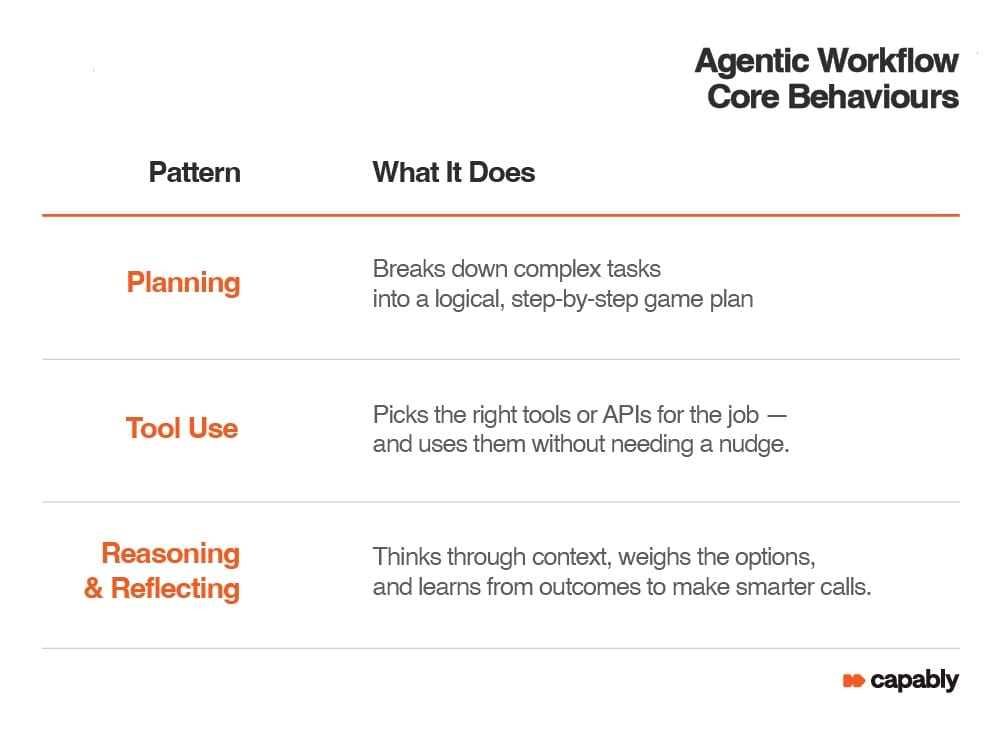
Put together, these patterns enable agentic workflows to operate autonomously inside complex systems, executing tasks effectively while reducing human intervention. With large language models at their core, and feedback loops that evolve, they turn routine processes into intelligent ones, ready to scale with your business.
AI Agentic Workflows vs. Traditional Workflows
With agentic workflows now in focus, it’s worth stepping back to compare them with what most businesses are still using today: traditional workflows. These are rule-based and rigid. They move tasks from point A to point B with humans in the loop at every turn. It works—until routine tasks get complicated, the environment changes, or you need to scale fast. Then, things start to break down or bottleneck.
AI Agentic workflows, on the other hand, bring in intelligent agents. These are AI systems that can plan, act, and adjust in real time. They break down complex tasks into manageable steps, make data-driven decisions, and improve as they go. And they do it with minimal human oversight.
Here’s how the two approaches stack up:
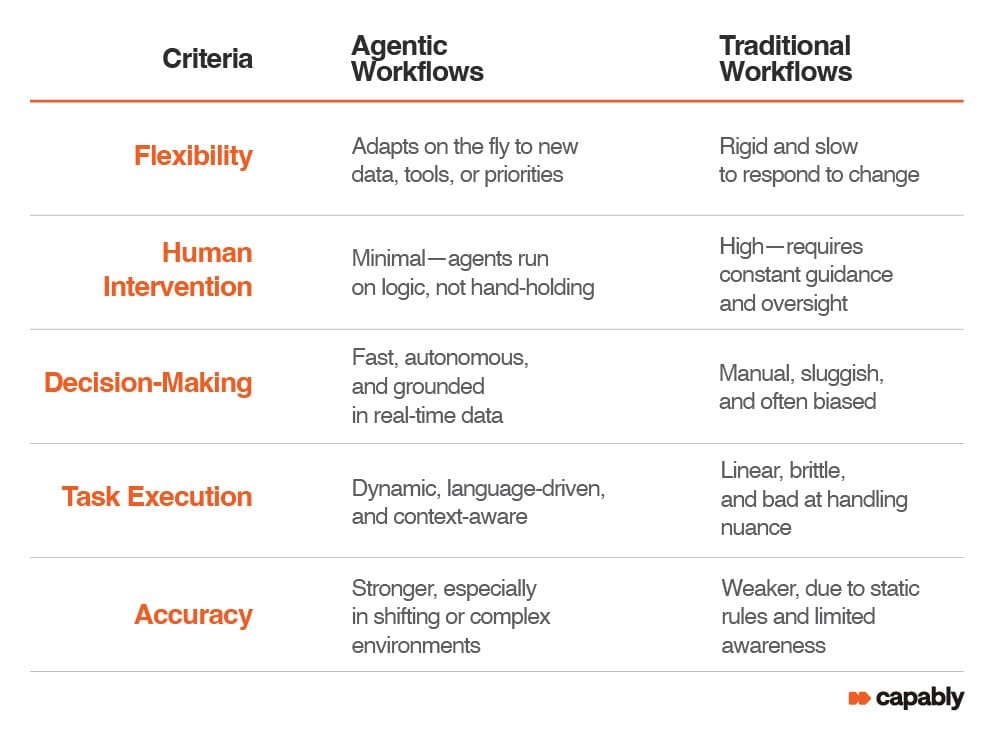
By using machine learning, specialised agents, and smart workflows powered by core components like planning and reasoning, agentic systems can do far more than just automate routine work. They handle complexity, reduce operational costs, and boost the user experience along the way.
In short, agentic AI workflows aren’t just a tech upgrade—they’re a rethink of how work gets done.
How to Create Agentic Workflows without Coding
Let’s be honest, agentic AI agents sound like something that should come with a warning label and a team of senior developers. Between the terms like “autonomous reasoning” and “multi-agent coordination,” it’s easy to assume this kind of automation is reserved for tech giants or companies with deep IT benches.
But thanks to platforms like Capably, that’s no longer the case.
Capably is an autonomous AI platform built with non-technical users in mind. It takes the complexity out of building agentic AI workflows and replaces it with a clean interface, drag-and-drop logic, and practical tools any team can understand. No code. No bottlenecks. No waiting on IT to translate business needs into automation—marketing, ops, HR, and finance can build and manage their own agentic workflows.
In the next two sections, we’ll show you two ways to get started:
- One-click solutions with the Workflow Library
- And building your own from scratch (still no coding required)
Let’s take a look at what it actually takes to bring agentic automation into your business, the easy way.
1. Workflow Library
Not every business has the time—or the appetite—to reinvent the wheel. That’s where Capably’s Workflow Library comes in. It offers a growing collection of prebuilt agentic workflows for common tasks across departments: sales follow-ups, customer onboarding, invoice processing, HR scheduling, market research, campaign reporting, you name it.
Each workflow is powered by intelligent agents and built to run autonomously. And here’s the beauty: you don’t have to build a thing. Just pick what you need, follow your AI agent’s lead: answer a few practical prompts like “what,” “when,” and “where,”and you're off.
Here’s how it works:
Start by selecting the department you want to automate. Let’s go with Marketing.
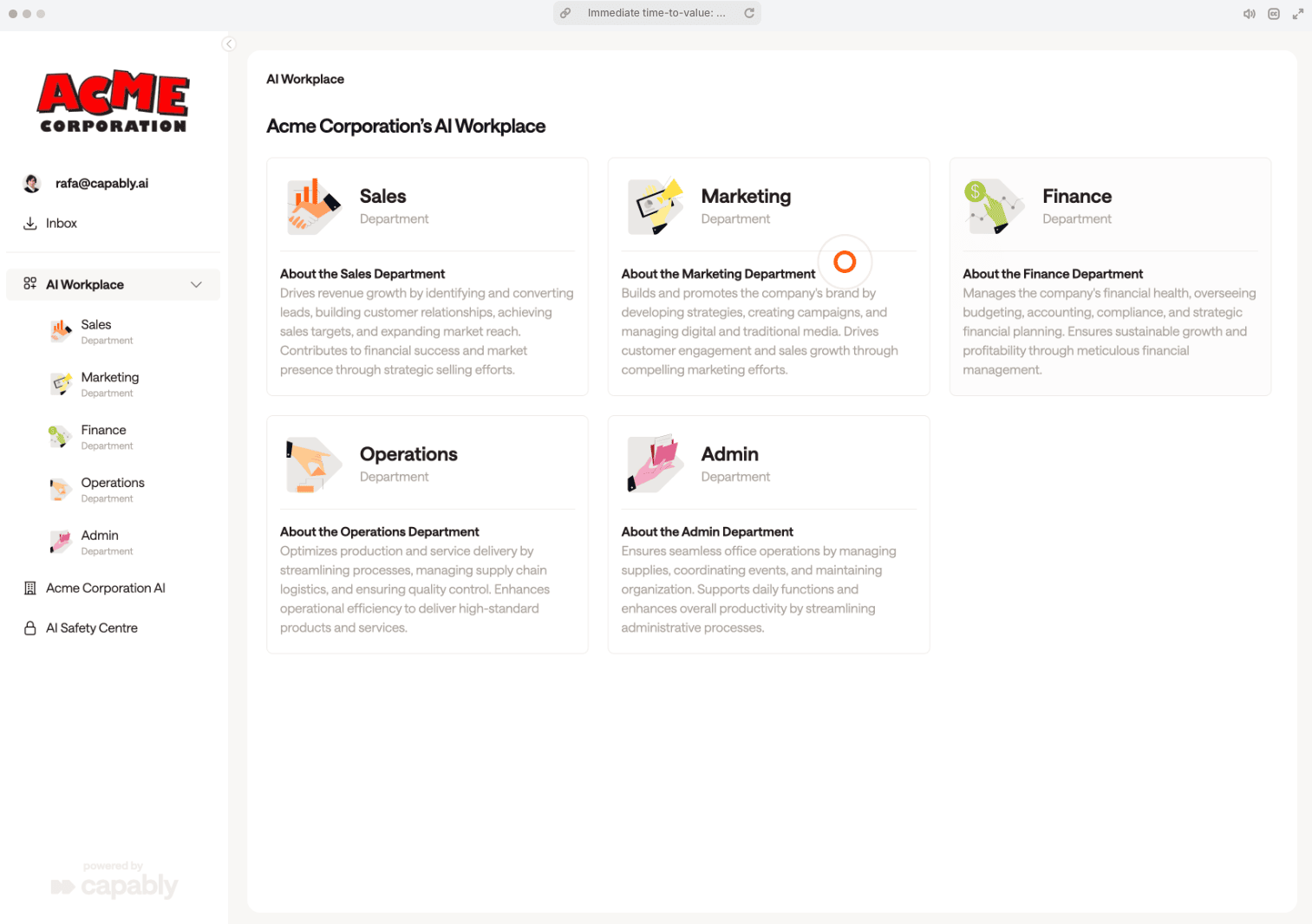
Next, choose the Library option.
You’ll see a menu of common marketing processes ready for automation—things like campaign reporting, fact checking, keyword performance tracking, media planning, and more.
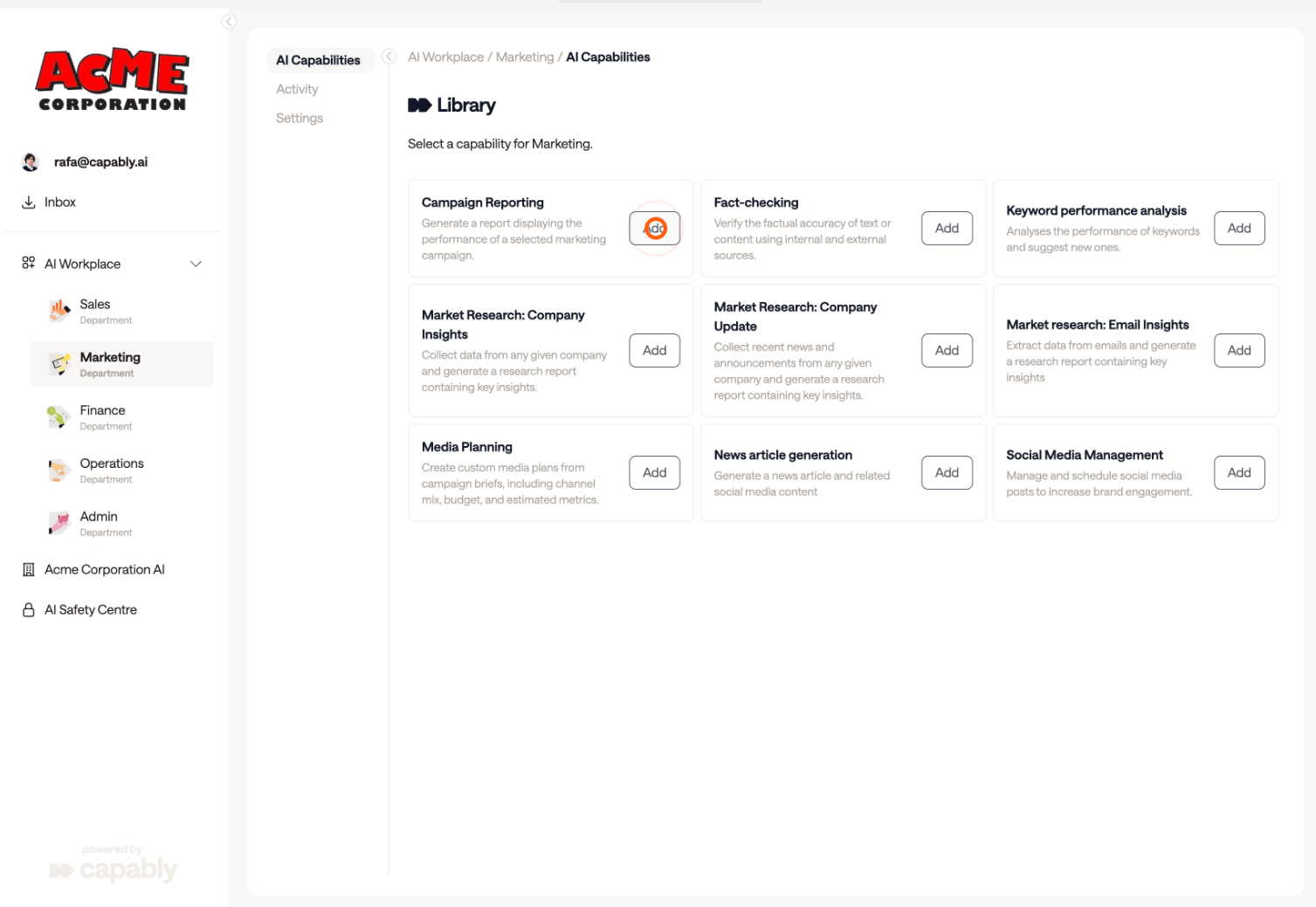
Let’s say we pick Campaign Reporting.
Capably’s setup interface is straightforward and intuitive. Rather than telling the system what to do, you simply respond to what it asks—the AI agent already knows what it needs to complete the task.
For campaign reporting, it starts by asking for access to Google Ads.
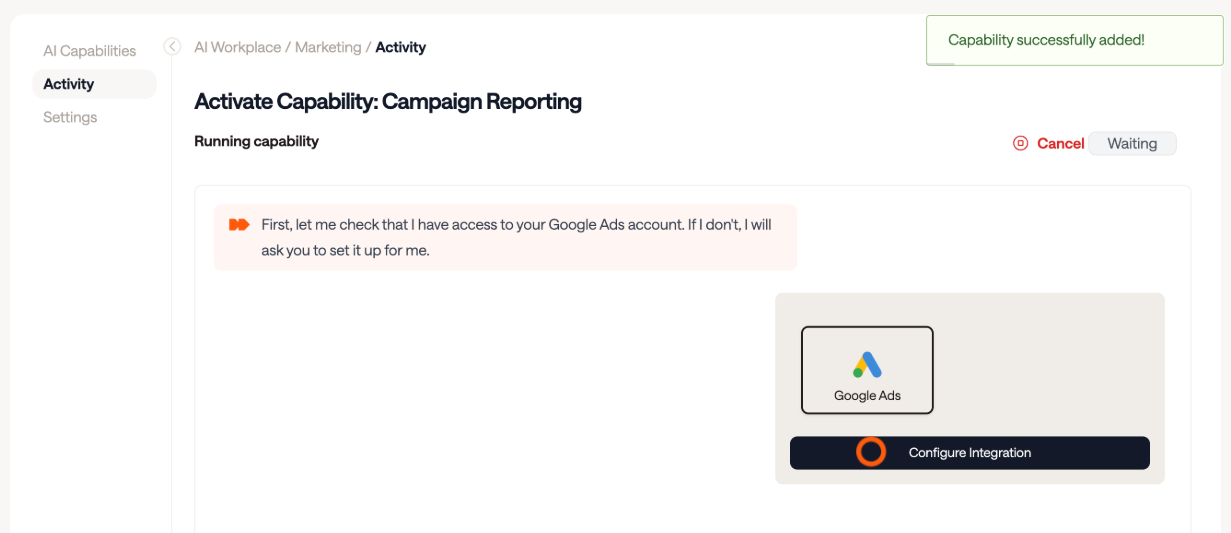
Then, it’ll prompt you to:
- Identify the overseeing manager account
- Select the client account and the specific campaign to use as the basis for the report
- Choose the report title, number of elements in the analysis, and even a color palette for the presentation.
Once submitted, the agent gets to work. You don’t need to babysit it. Just check the Activity tab to monitor progress. There, you’ll see all automated tasks, whether they’re upcoming, in progress, under review, or completed.
If the agent needs anything from you—say, to confirm the report format—you’ll get a prompt or notification.
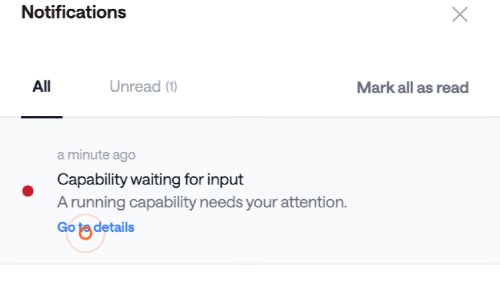
In our example, the AI capability requires us to confirm the rport format
In our example, the AI checks permissions, confirms formatting details, and just seconds later, your report is ready.
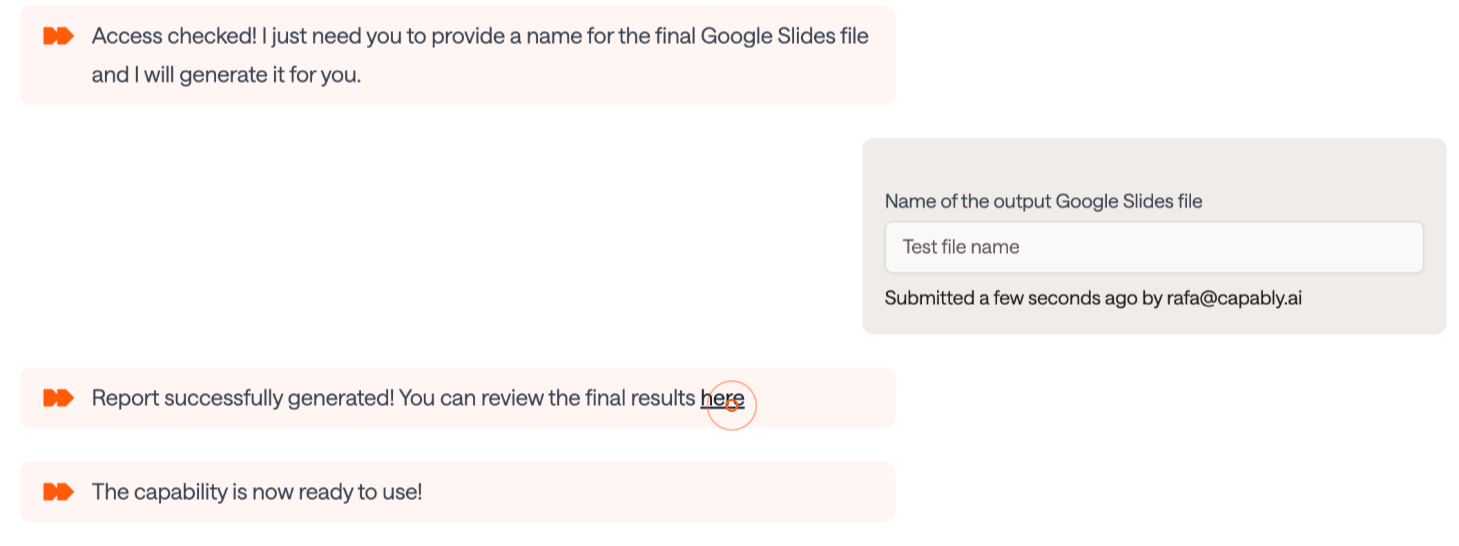
Let's check it out:
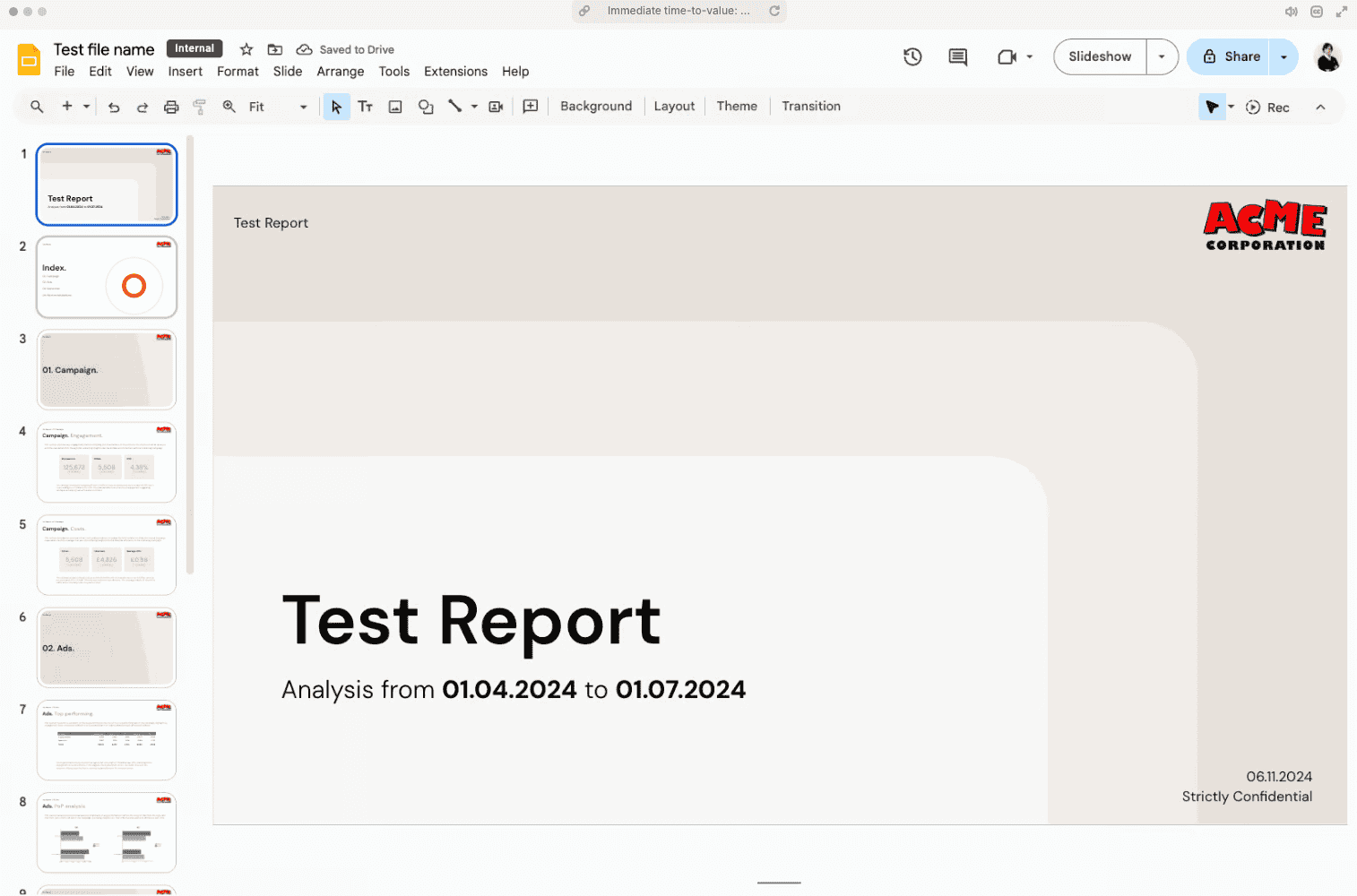
Here’s the kicker: the system doesn’t just present raw data. It pulls performance metrics from Google Ads, analyses them using large language models (LLMs), and delivers clear commentary on key insights.
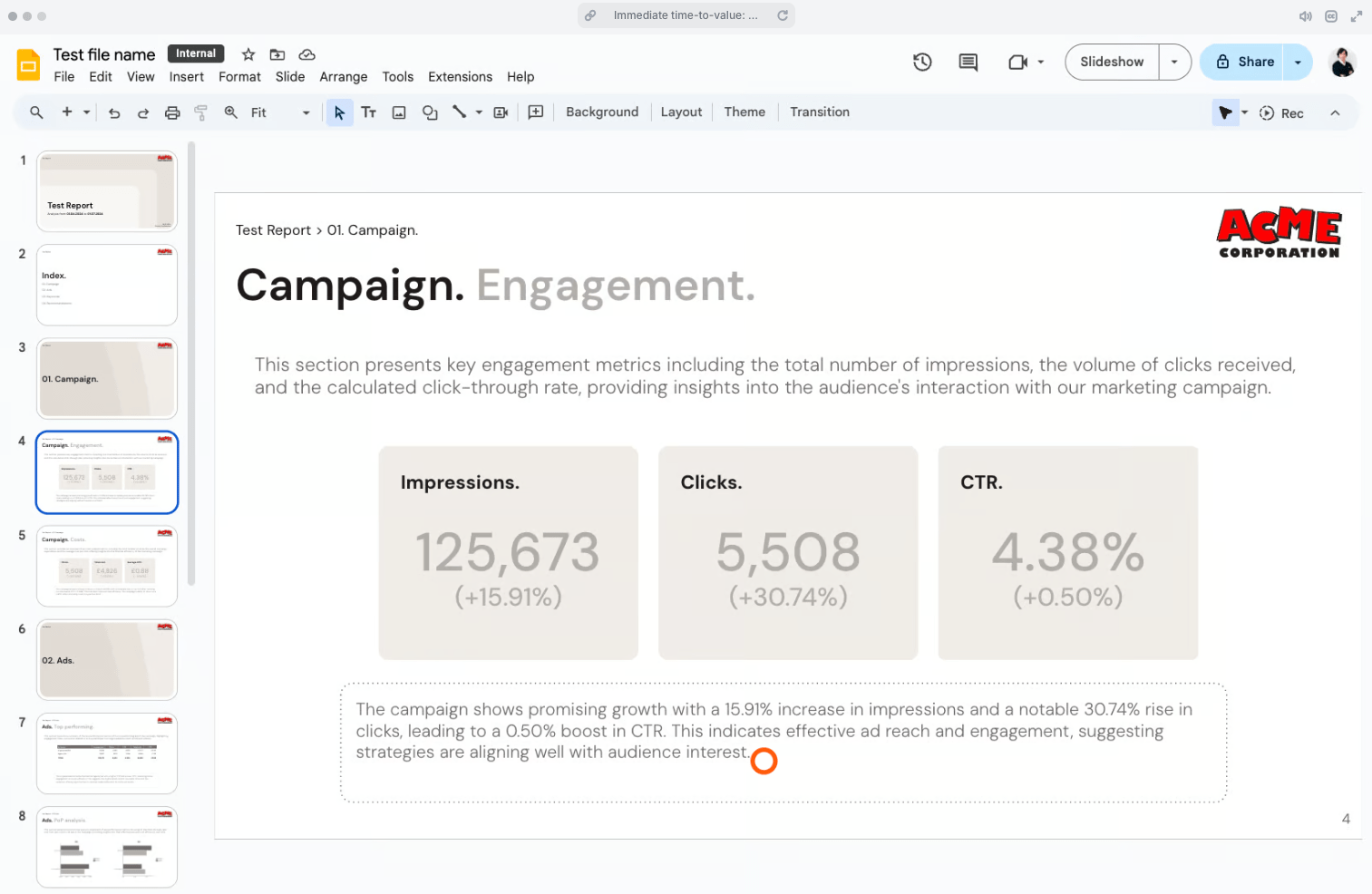
At the end of the report, it even generates data-backed recommendations for your next campaign.
Whether you’re automating routine tasks or standing up a last-minute solution, Capably’s Workflow Library makes it fast and frictionless—no dev team required.
Need a weekly report sent every Friday? Easy. Want a support agent that triages requests in real-time? Also easy.
This isn’t automation that lives in the back office—it’s right where the work gets done.
In short: smart workflows, ready when you are.
2. Create Agentic Workflows from Scratch
Capably’s Workflow Library is extensive, but sometimes your business needs something a bit more bespoke. If a prebuilt workflow doesn’t quite fit the bill, no problem—you can easily create your own agentic workflow from scratch. And don’t worry, it’s just as low-effort as using the library.
Thanks to Capably’s agentic AI and its unique “Describe–Criticise–Automate” pattern, building custom workflows doesn’t require coding or technical know-how. You just tell the system what you want, and it figures out how to get it done—no matter how complex the task, which external systems are involved, or who needs to contribute.
Here’s how it works:
Let’s say we’re in the Operations Department. This time, instead of choosing Library, we’ll click Create AI Capability.
The setup begins with a simple question: “What do you want the platform to do?”
Type it out in plain language—no special formatting, no formulas.
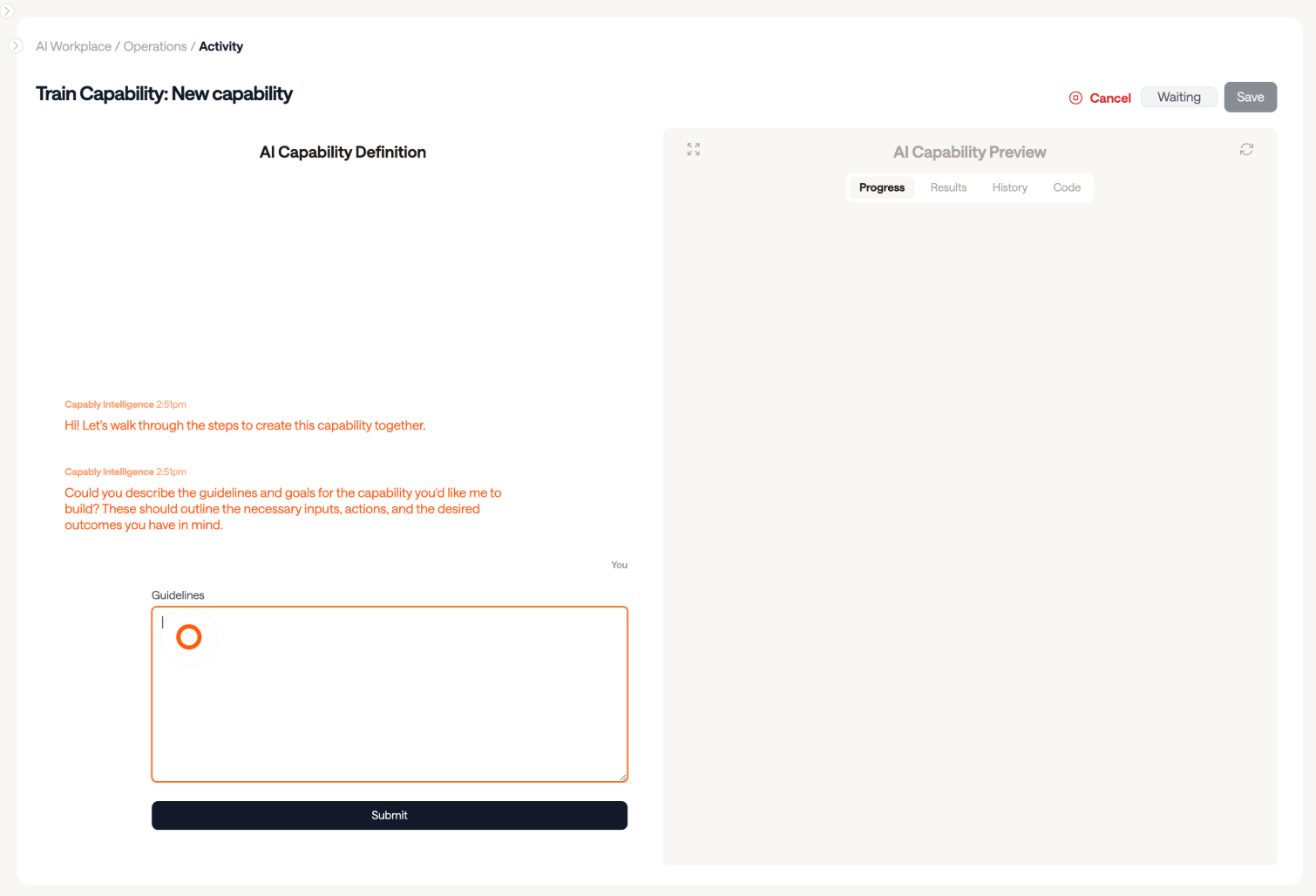
In this example, we want to research a list of potential VCs investing in our space. The system should:
- Ask us for the list of VCs.
- Research each firm’s thesis, investment size, and typical ticket.
- Compile and analyze the results.
- Create a dedicated webpage to display the information.
- Email the final report to a specific stakeholder.
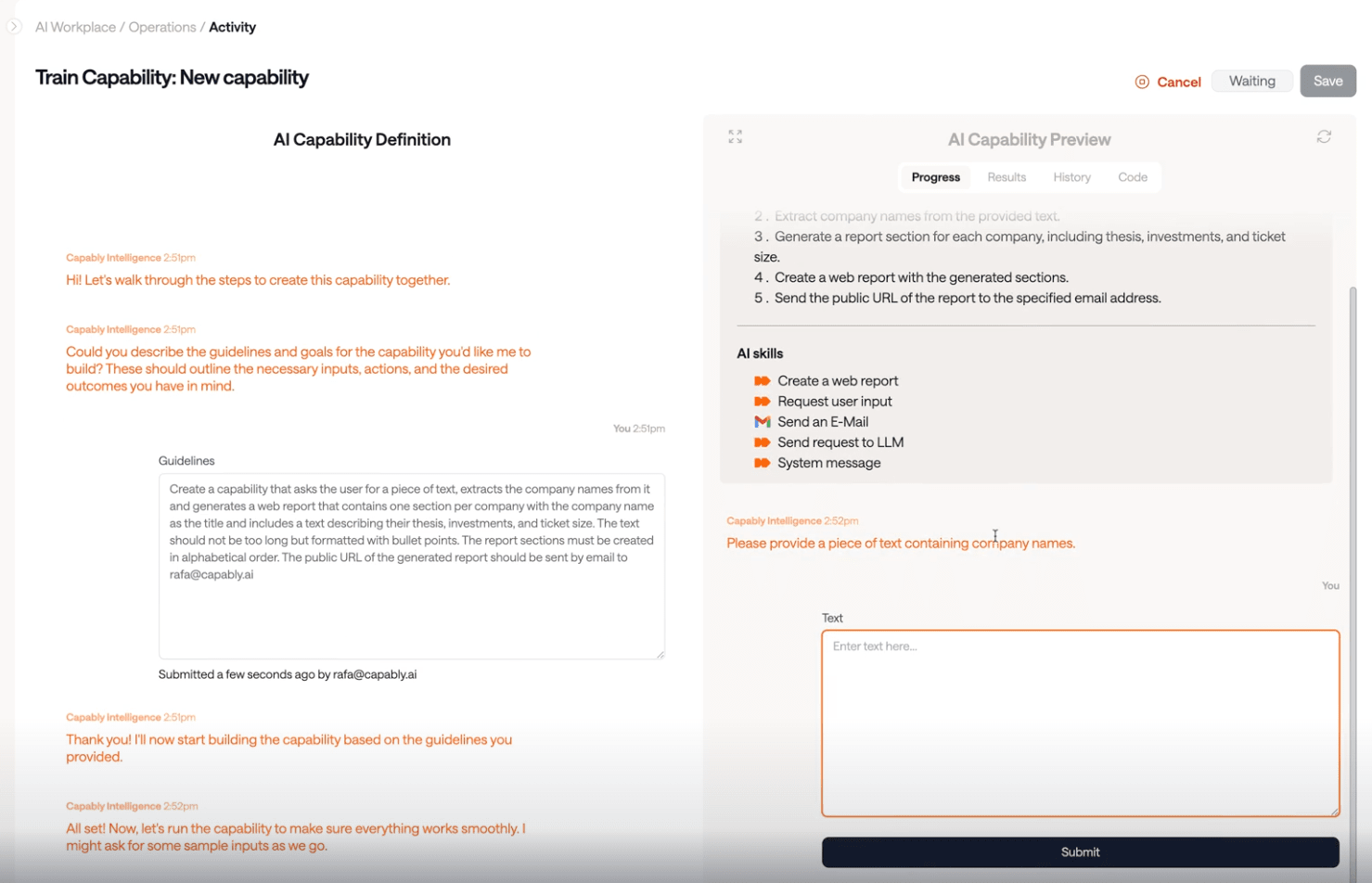
Once submitted, Capably’s engine gets to work. It automatically breaks your description into an actionable plan and assigns the necessary capabilities:
- Gen UI to request your input
- LLMs to handle research and analysis
- Webpage code generation to display the findings
- Email automation to deliver the report
Let’s test it. We enter a few VC names, submit, and let the system run.
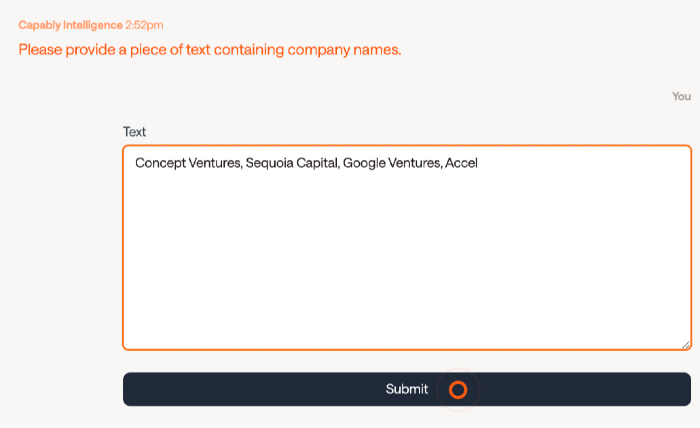
When it’s done, the report is sent—and the webpage is live:
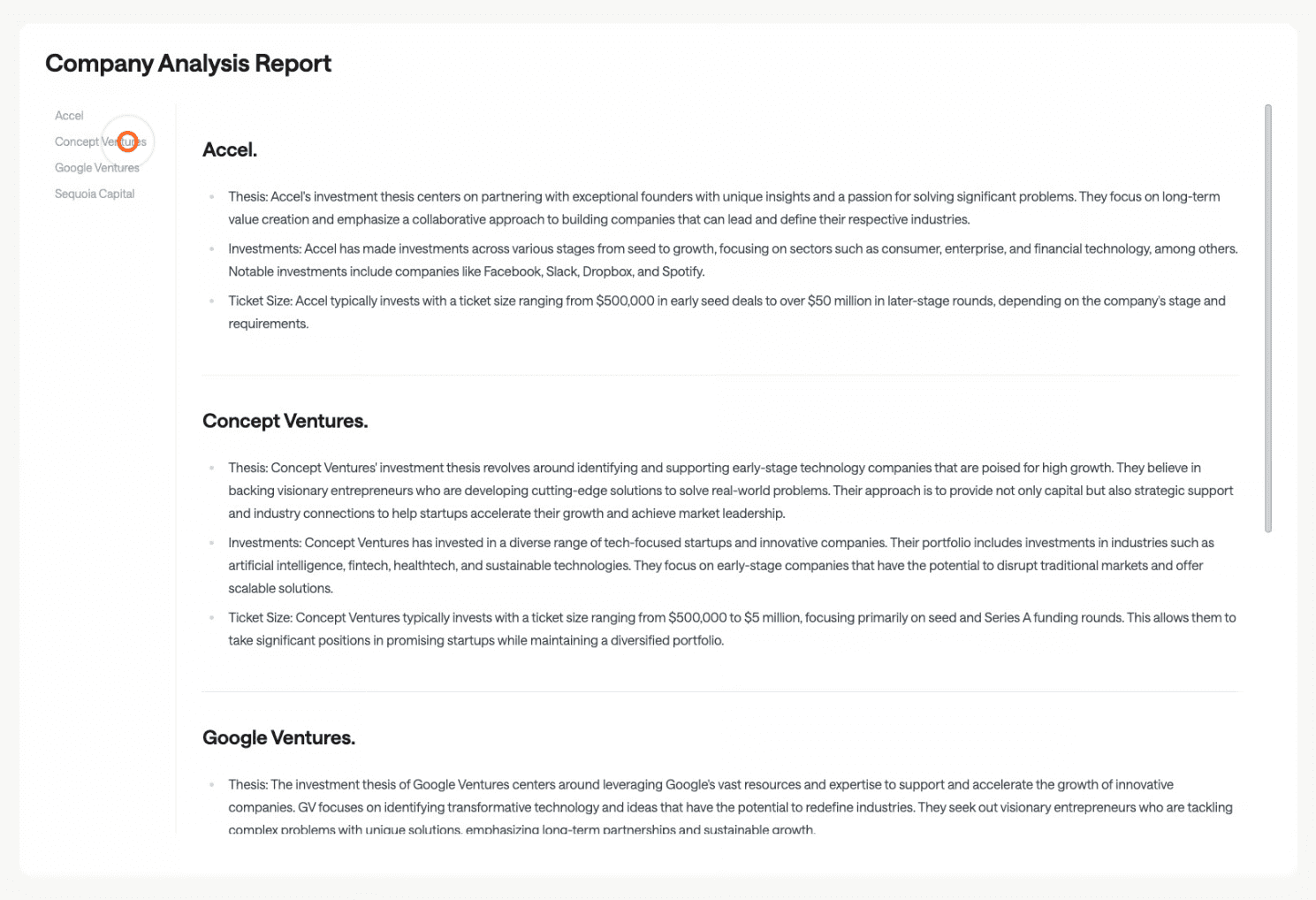
On the left-hand panel, you’ll see the AI Capability Definition field. This is where you can review results and give feedback if the output isn’t quite right.
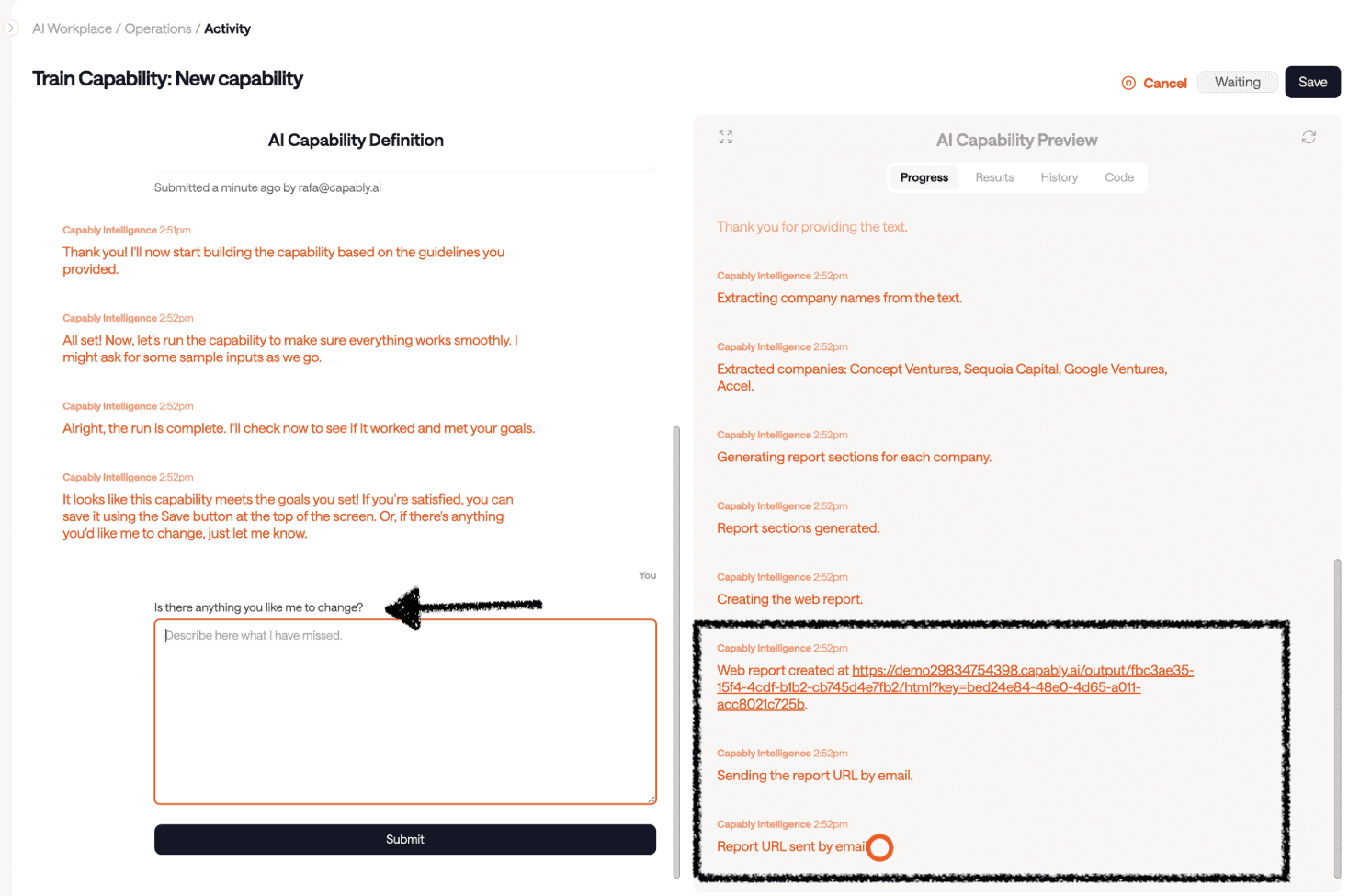
For instance, we can ask it to include each VC’s official website so we can see how they present themselves publicly. Submit the update, rerun the process—and voilà, now the analysis includes websites too.
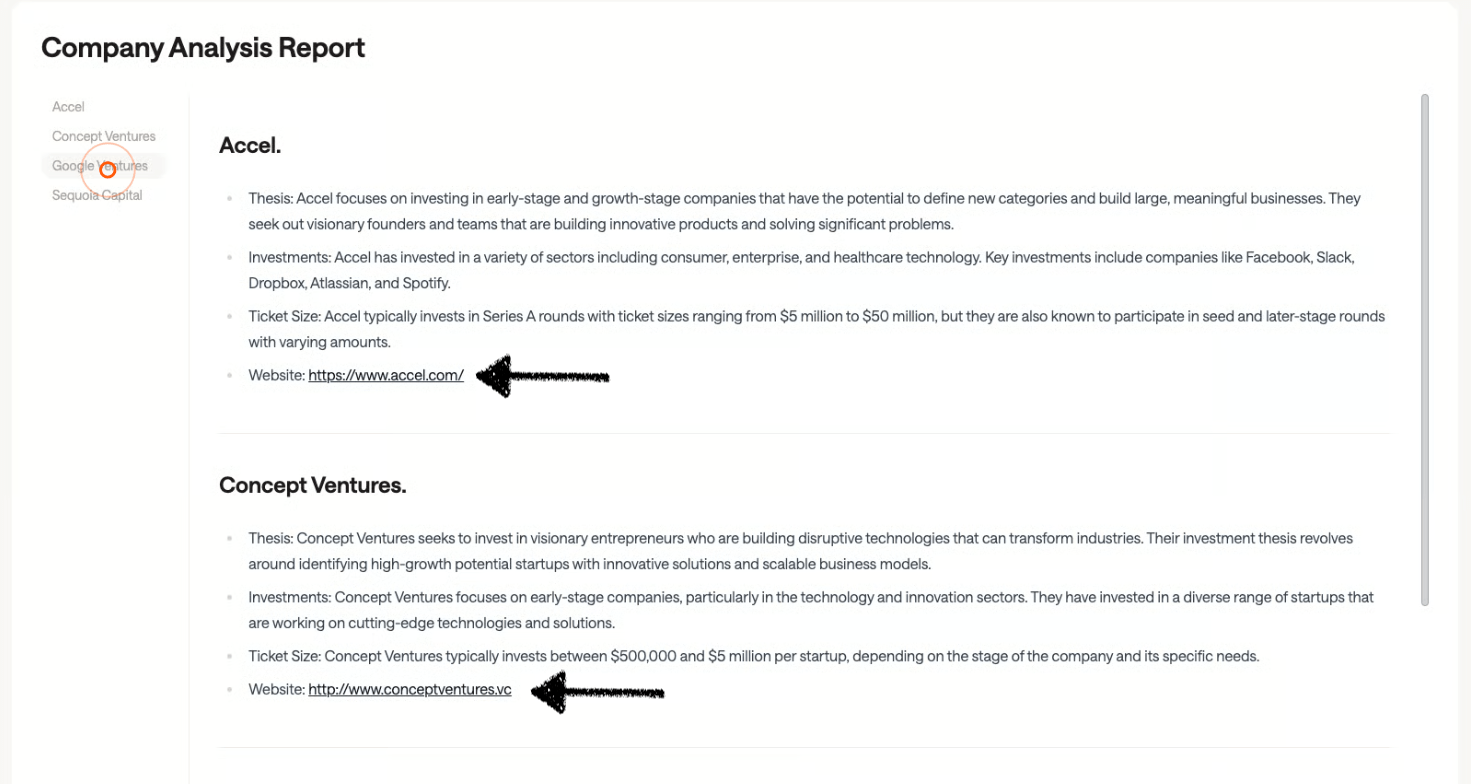
Once everything looks right, just click Save.
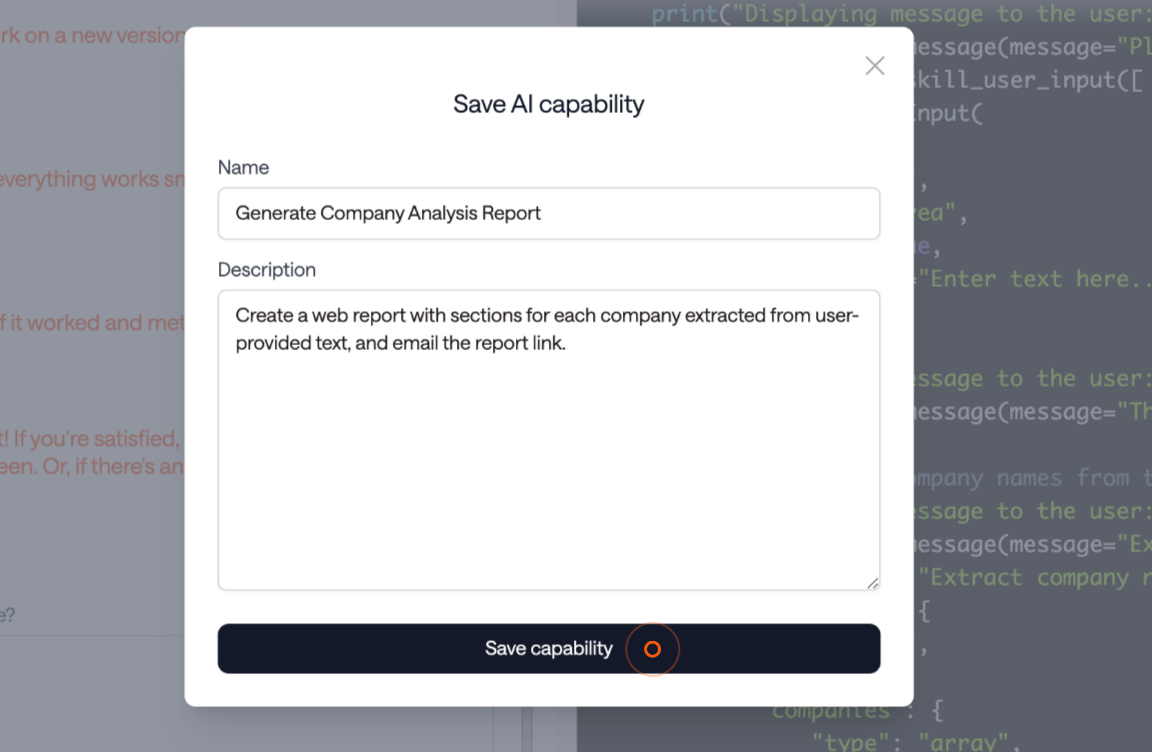
Your new workflow is now part of your personal AI Capability Library, ready to use again anytime.
Behind the scenes—the parts your employees don't get to see—Capably is blending AI code automation with classic process automation, creating a hybrid system of deterministic steps and intelligent actions powered by LLMs.
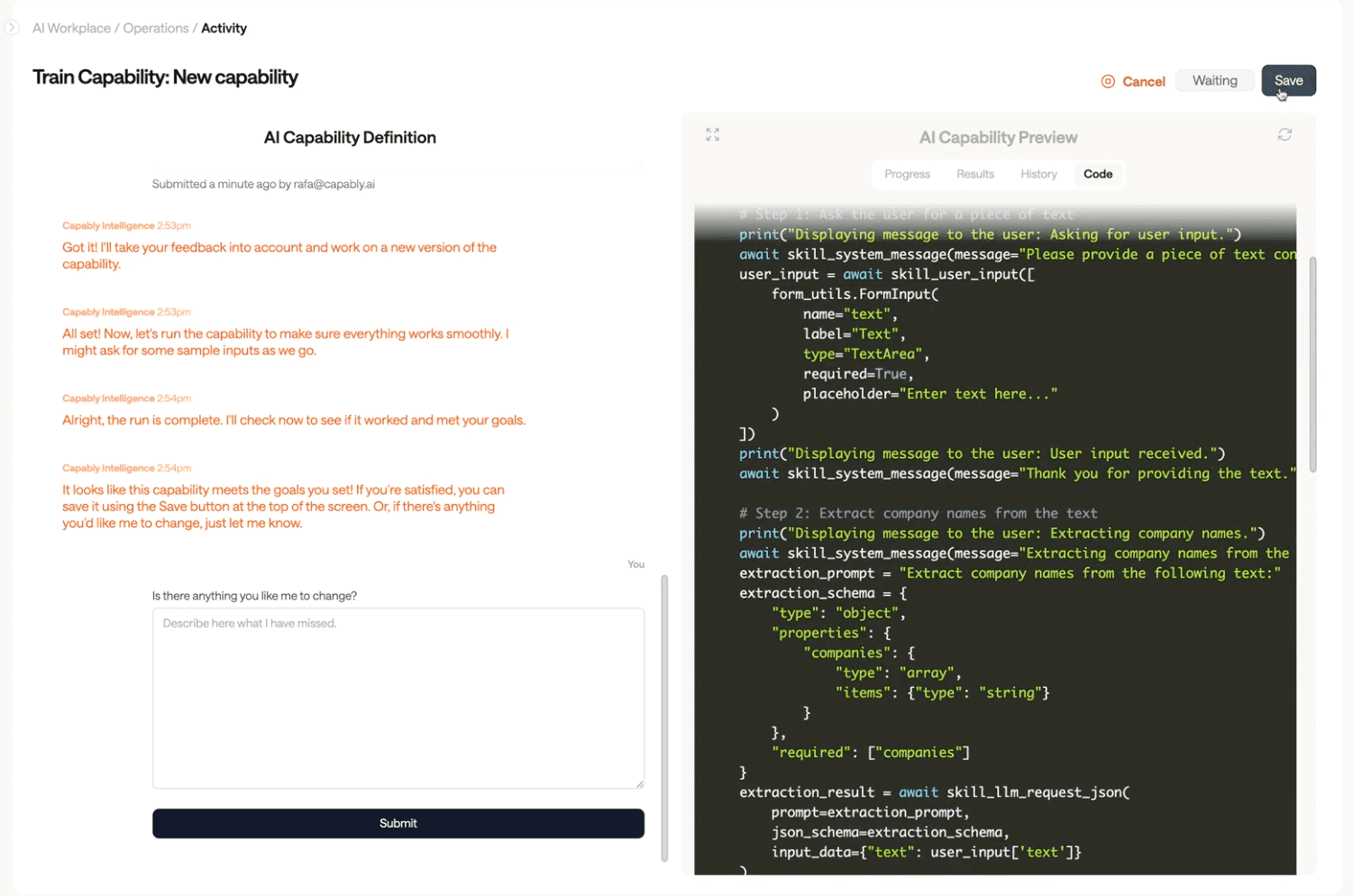
This layered approach means you get robust, reliable workflows that are smart enough to adapt—and simple enough to delegate completely.
Custom automation, minus the complexity.
Best Practices for Building Agentic Workflows
Agentic AI workflows are powerful but only if they’re built and implemented with intention. Like any system involving intelligent automation and complex tasks, success comes down to structure, clarity, and iteration. Here’s how to get it right from the start.
1. Define Clear Roles and Goals
Before agents can do the work, they need to know what success looks like. Assign specific roles to each agent and tie their responsibilities to clear business objectives. This tight alignment is what enables precise, effective task execution and avoids agents wandering into the digital weeds.
2. Break Down Complex Tasks
Big workflows don’t work without small parts. Decompose larger challenges into manageable steps that agents can handle independently. This not only improves accuracy, it also lays the groundwork for scale and flexibility across complex systems.
3. Enable 24/7 Operations
One major advantage of agentic workflows: they don’t sleep. Design your workflows for round-the-clock operation to eliminate downtime and keep core business processes running without the burnout.
4. Plan for Scalability
A good workflow today should still work when you double your customer base. Design with scalability in mind so your systems grow with you without the usual manual rework.
5. Automate the Right Things
Use a mix of language models, robotic process automation, and agents to handle both repetitive and complex work. Free up your team to focus on strategy, creativity, and customer relationships, the things machines can't (yet) replicate.
6. Encourage Multi-Agent Collaboration
Some jobs are better shared. Create workflows that enable cooperation between specialised agents and human counterparts. This leads to faster execution, fewer errors, and more data-driven decisions.
7. Build for Continuous Improvement
Don’t “set and forget.” Make reflection and feedback loops part of your system, so agents can self-correct and improve over time. It’s how you go from “automated” to truly intelligent.
When done right, these practices turn agentic AI workflows into a competitive edge lowering operational costs, improving user experience, and giving your team the breathing room to focus on what matters most.
What are the Benefits of Agentic Workflows with Capably?
Agentic workflows mark a fundamental shift in automation by combining AI’s intelligence with automation’s scale. With Capably, businesses can tap into this power without the usual technical barriers. The platform makes it easy to deploy intelligent, autonomous systems that execute complex tasks, adapt in real time, and reduce operational load—no IT degree required.
Increased Efficiency
Capably’s agentic workflows break down complex processes into manageable steps, enabling intelligent agents to handle tasks methodically and without delays. They run 24/7, eliminate manual bottlenecks, and free up your team for higher-value work. Thanks to built-in self-improvement, they get faster and smarter over time.
Smarter Decision-Making
Powered by AI reasoning, planning, and tool use, Capably workflows make context-aware decisions with minimal human input. Whether analysing performance data or triaging requests, these agents handle nuanced tasks reliably helping teams act faster and with more confidence.
Improved Accuracy
The Capably platform leverages iterative feedback loops and multi-agent collaboration to improve results. By drawing from real-time data and refining outputs through reflection, Capably workflows deliver more accurate, consistent outcomes. Especially in areas like analysis, reporting, and content creation.
Greater Agility
Markets move fast, and Capably keeps up. Its agentic workflows adapt in real time to new data, shifting priorities, or customer demands. No need to rewire systems. Just update the task, and your agents adjust accordingly. It’s automation built for dynamic environments.
Effortless Scalability
Whether you're automating five processes or fifty, our platform makes scaling seamless. The system intelligently allocates resources and evolves workflows as complexity grows, so performance stays consistent, even during peak demand.
Cost Savings
Automation technologies like Capably reduce the need for constant oversight and manual execution, cutting operational costs while increasing output. The result? More work gets done with fewer resources, allowing you to invest in strategic initiatives instead of firefighting repetitive tasks.
What are the Top Agentic Workflow Use Cases?
Agentic workflows with the help of autonomous AI agents are already streamlining operations across departments, from the everyday to the mission-critical. They handle complex, multi-step tasks autonomously, freeing teams from repetitive work and enabling faster, smarter execution.
Some real-world examples:
But that’s just scratching the surface. With platforms like Capably any department can turn manual processes into intelligent, self-improving workflows. Whether it’s onboarding vendors, generating reports, vetting leads, or synthesising market research. If you can describe it, Capably can automate it.
In short: the agentic AI use cases are endless. The only limit is what you want to stop doing manually.
Final Thoughts
Agentic workflows aren’t just a tech trend—they’re a practical leap forward in how work gets done. By blending intelligent automation with everyday processes, they open the door to faster execution, sharper insights, and more space for people to focus on what actually matters.
And with platforms like Capably, this isn’t just for IT teams or automation experts. It’s for you—the marketer launching campaigns, the ops lead chasing efficiency, the customer support manager scaling fast. Whether you're picking a prebuilt workflow or designing your own from scratch, Capably makes powerful automation accessible without the complexity.
The future of work isn’t just smarter. It’s happening now—and it’s agentic.
Ready to build workflows that think, act, and improve on their own? Let’s get started.
FAQs
How do agentic workflows scale across teams or departments?
Agentic workflows can start with a single use case, like automating report generation, and then scale horizontally across departments, from sales enablement to HR onboarding. Capably supports modular design, making it easy to replicate and adapt workflows for different teams without starting from scratch.
What skills do I need to design agentic workflows with Capably?
You don’t need technical expertise. Capably’s platform enables anyone—product managers, marketers, operations leads—to describe tasks in plain language. The system then orchestrates the agentic logic, tool usage, and decision-making steps automatically.
What’s the difference between agentic workflows and standard automation tools like RPA or Zapier?
Traditional automation tools (like RPA or Zapier) follow rigid, pre-defined paths. Capably’s agentic workflows introduce goal-driven behaviour, enabling AI agents to make decisions, adapt to changing inputs, and use external tools as needed, without step-by-step scripting.
How do I ensure the quality and safety of an agentic workflow?
Quality depends on task clarity and feedback loops. Capably provides a structured approach—breaking tasks into subtasks, simulating actions, and incorporating validation. It's a closed-loop system with plan-act-reflect cycles that ensures agents learn and improve safely over time.
What kinds of tools and APIs can agentic workflows connect to in Capably?
Capably supports integration with thousands of tools via APIs, from CRMs and databases to scheduling platforms and LLMs. Its agents can plan which tools to use and in what sequence, giving businesses full autonomy without writing integration code.
Can Capably help me monitor or audit my agentic workflows over time?
Yes. Capably includes built-in analytics, versioning, and performance monitoring. You can track agentic workflow behavior, spot inefficiencies, and refine agent roles based on data, all within a unified interface.